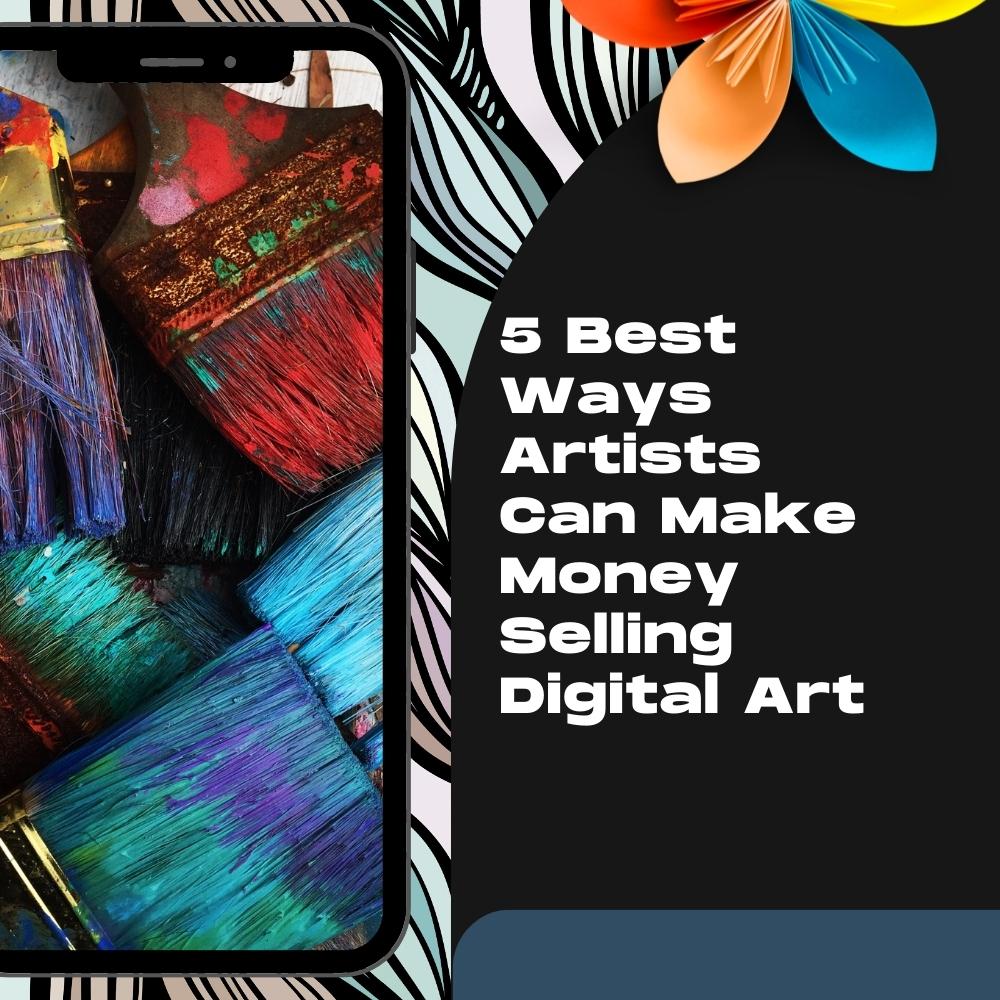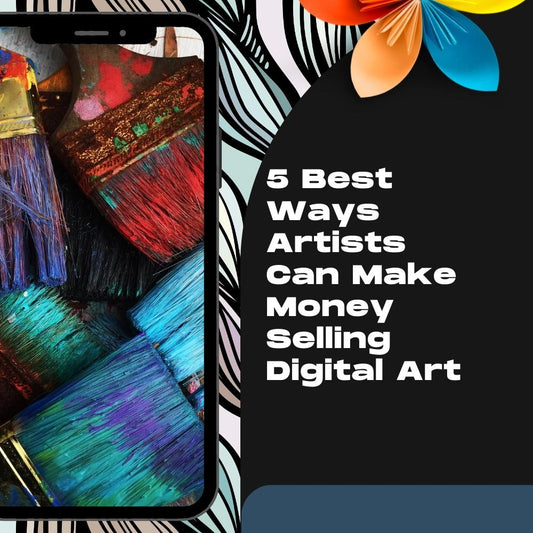You must have always dreamt of turning your hobby into a full-time job so that “you don’t have to love what you do, but can instead, do what you love.” However, the road to making money out of your passion can sometimes be confusing. Likewise, you might be wondering how you can make money selling the digital arts you create.
Here are five ways you may try to make money selling digital arts.
- Upload Your Digital Art To Print-On-Demand Sites
- Sell Your Digital Art At Stock Image Websites
- Take Commission Jobs
- Work On Freelance Projects
- Sell Digital Stickers, Fonts, And Phone Themes And Icons
Follow along to learn more!
1. Upload Your Digital Art To Print-On-Demand Sites
Uploading your digital art to Print-On-Demand Sites and making money out of it can be a great option you may choose. But before I guide you through how you can do that, let's discuss what Print-On-Demand sites are and how they work!
A Print-On-Demand site is where you can upload your digital artwork, the company then prints your artwork on physical products (T-shirts, cups, bags, cap, etc.) and sell them on a per-order basis with your designs.
So, every time someone places an order with their design on it, the artist will get the royalty fee. Here, you won’t have to pay any cost of the product until the product has been shipped.
Below I’ll be listing down five of the best Print-On-Demand sites you may try to sell your digital arts.
- Printful
- Printify
- SPOD
- CustomCat
- Sellfy POD
Printful
Printful is, without doubt, the most popular print-on-demand site as they provide great customer service and are easy to use compared to other similar sites. They have a large selection of products that you may get customized and ship directly to your customers.
The pros and cons of choosing Printful as your print-on-demand site are discussed below.
Pros of Printful
- User-friendly and easy to use.
- No upfront or monthly fees.
- Consists of five fulfillment center in North America and Europe, making it easier to ship your products worldwide.
- Everything is automated including printing, packing, and shipping by the Printful factory.
- Products are ready to be sent in two to five business days.
- You can track if your products reach your customers or not.
Cons of Printful
- Few of the products cannot be shipped worldwide.
Printify
Printify is another great option as they have over 200 print-on-demand products to choose from. Based on your location, the fulfillment time, and the product base price, you can select the print provider that can do the best job by using their network of print suppliers.
So what are the pros and cons of Printify?
Pros of Printify
- Zero cost to get started.
- Consists of a free mockup generator so that you can see how your product will look before it’s printed.
- Freedom to check the product quality before starting to sell to your customers.
- Full control in customizing the shipping label so that it looks like the product has been delivered directly from you.
Cons of Printify
- Slow customer service response.
- Printify’s mockup generator can sometimes be glitchy.
SPOD
With a two-day turnaround, SPOD is one of the print-on-demand companies with the shortest turnaround times available.
Digital direct, laser transfer, special flex, and sublimation are just a few of the printing possibilities that SPOD provides. Additionally, you can sell more than 100 products using the SPOD’s service.
Now let's list down the pros and cons of choosing SPOD as your print-on-demand site.
Pros of SPOD
- Competitive pricing.
- High-quality products.
- Low return rate.
- Easy-to-use customizer tool.
- Effortlessly integrates with your Shopify store.
Cons of SPOD
- Limited product range as compared to their competitors.
- Only works with Shopify.
CustomCat
Using CustomCat, purchases can be usually shipped out within two to three business days. CustomCat offers a few printing possibilities, including sublimation, 3D dye infusion, and direct-to-garment printing.
So what are the pros and cons of using CustomCat?
Pros of CustomCat
- There are more than 500 goods available.
- WooCommerce and Shopify both have direct integration with CustomCat.
- They provide a service with a full white label.
- You can choose from a range of printing options.
- You can benefit from better profit margins compared with other POD companies, thanks to their competitive pricing.
- They always produce the highest-quality products by utilizing the most recent technology.
Cons of CustomCat
- Only Shopify and WooCommerce have native integrations with CustomCat, therefore if you wish to sell on another e-commerce platform, you will need to manually submit your orders or use the API.
Sellfy POD
In my opinion, Sellfy POD is one of the best platforms to sell digital products as it has all the features including SEO-friendly URLs and tags, integrated analytics, and multiple payment getaways.
The pros and cons of Sellfy POD are listed down below:
Pros of Sellfy POD
- Easy to use.
- Instant payouts.
- Improved analytics compared to most POD services.
- Supports a variety of languages.
- Zero transaction amount.
- Page layouts that can be customized.
Cons of Sellfy POD
- Limited customer support.
- The basic plan lacks email marketing features.
- Not specifically built for print-on-demand.
- Tools for managing affiliate marketing are lacking.
Along with this, I have some other suggestions of print-on-demand sites that you may want to try beyond the names mentioned above. You may try Zazzle, TPop, Gooten, Gelato, Printy6, TeeSpring, and so on.
2. Sell Your Digital Art At Stock Image Websites
Another option for digital artists to make a living is by selling their digital art on stock image websites. This is a great way to make passive income. All you’ll have to do is upload your digital art images on these stock websites and you’ll get paid a certain percentage of whatever price your image sells for.
The stock markets typically begin at a low fixed price, but as demand for your products increases, your payout will increase.
Some of the popular stock image websites are:
- Adobe Stock
- Shutterstock
- Etsy
- Alamy
Adobe Stock
The company that produces Photoshop and Lightroom, two of the most well-known photo editing software, operates Adobe Stock (formerly known as Fotolia), a stock photo marketplace. This website has been in existence for more than ten years and is renowned for being the first internet marketplace to sell images.
Pros of Adobe Stock
- Higher royalty share compared to other stock image websites.
- Freedom to sell on other platforms along with Adobe Stock.
- Smart search feature.
- Images on Adobe Stock are available on the Adobe Stock library, making the images available on other Adobe applications as well. This increases the reach and potential buyers.
Cons of Adobe Stock
- No audio files.
- Costly premium images as compared to standard images.
Shutterstock
Online stock photo purchases have been made on Shutterstock for more than 15 years. They offer more than 200 million royalty-free photos, movies, and music files, which also implies that they have millions of paying customers.
Pros of Shutterstock
- Allows keeping your copyrights protected on your works.
- Freedom to sell on other platforms along with Shutterstock.
- Gives credit to the owner of the image.
- Low payment threshold.
Cons of Shutterstock
- Low price per picture after the sale.
- Takes a lot of effort to gain profit out of it.
- Strict requirements need to be fulfilled for the images to get uploaded.
- Difficult to estimate the growth.
Etsy
Etsy is not typically a stock photo site but is popular to have over 30 million users and can be a good platform to expose your work to a greater number of potential customers.
Pros of Etsy
- Established audience than most stock image websites.
- You can set a price of your own for the works you sell.
- Easy to set up.
- Established payment system.
Cons of Etsy
- Increased competition.
- We need to put effort into marketing.
Alamy
Another excellent venue for selling stock photographs is Alamy because there aren't any strict guidelines there. Although the site may not have as many customers as Shutterstock and Adobe Stock, it is nonetheless a strong competitor and a fantastic source of income.
Pros of Alamy
- Photographers don't need a license or worry about any other copyright issues when they post their images to Alamy.
- The market pays photographers 50% of each sale if their annual sales surpass the $25,000 cap; 40% of each sale if their annual sales are between $25,000 and $250; and 20% of each sale if their annual sales are below $250.
Cons of Alamy
- Do not have a large audience in comparison to Adobe Stock and Shutterstock.
3. Take Commission Jobs
A lot of artists and amateurs use this technique. To get commission jobs, what you can do is put your work on your portfolio website as well as social media networks or websites, such as DeviantArt, Twitch, and Artstation, together with your contact information and price information.
Potential customers will contact you for commission work. This is a fantastic source of extra money. And you have the choice of charging hourly rates or a fixed rate for this option.
DeviantArt
This website features groups and a career forum. But keep in mind that since DeviantArt tends to attract younger users, they might not want to invest as much.
Pros of DeviantArt
- Easy layout system.
- A good platform to meet like-minded individuals.
- Welcoming community.
Cons of DeviantArt
- Can be hard to get noticed.
- Fan art dominates other forms of art.
Twitch
Twitch, which was initially developed for gaming, now features a growing art sector. Clients can meet with you and observe your creative process thanks to this interactive platform.
Pros of Twitch
- Allows users to generate a healthy income.
- One of the most popular streaming platforms.
Cons of Twitch
- For a limited time, content is only available on Twitch.
- Twitch takes a commission from the money users make.
Artstation
Artstation is an excellent choice if you want to work in the entertainment industry as it allows amateur and professional artists to upload their portfolios. Artstation has gained popularity with art directors.
Pros of Artstation
- Easy-to-use interface.
- Do not need to create an account to follow other users.
- Faster loading rate.
Cons of Artstation
- Only one type of media is supported.
- One image upload limit.
4. Work On Freelance Projects
Taking up freelance work not only helps you with your finances but also helps build a stronger portfolio. While social media sites like Instagram and TikTok can be a great platform to showcase your arts, also consider getting on real freelancing sites to land freelance works.
Some of the top freelancing sites are:
Upwork
Upwork, one of the most well-known freelance websites in the world, is incredibly user-friendly and a fantastic resource for locating longer-term contracts or employment. I like taking works on Upwork as they have relatively higher-paying projects. Also! The payment system is really easy.
However, it can be tough to land your first work, and their website user experience is quite poor.
Fiverr
This platform might be for you if you prefer to be paid per gig rather than per hour. On Fiverr, there is no need to bid on your services. Also, it can be a great platform to broaden your skills.
However, Fiverr has high commission rates, and can also be difficult for beginners to start their freelancing careers.
5. Sell Digital Stickers, Fonts, And Phone Themes And Icons
Another great alternative to make money via your digital art might be by selling digital stickers, fonts, and phone themes.
People these days love using stickers on social media platforms. Thus, selling the art you created as stickers can be a great revenue alternative. People also buy fonts for UX interfaces, advertisements, and so on.
You may sell the stickers through the Google Play store or App store, and fonts via sites such as MyFonts, HypeForHype, etc.
Last Words
In conclusion, it is possible to make a living by selling your digital arts and there are different ways to do that. It depends on you which one (or maybe many!) to choose. Whether you take on commission jobs, start working as a freelancer, or sell your artworks, make sure to be consistent and put on your efforts!




